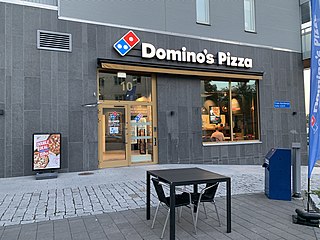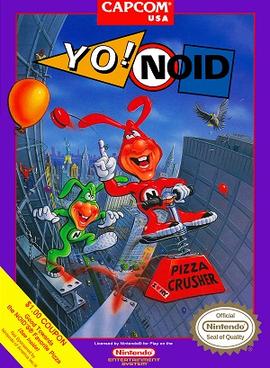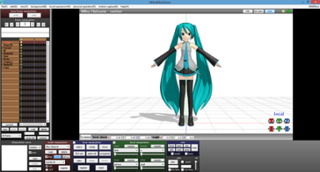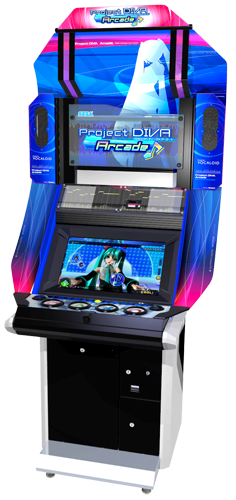Related Research Articles

Domino's is an American multinational pizza restaurant chain. Founded in 1960, the chain is owned by master franchisor Domino's Pizza, Inc. and led by CEO Russell Weiner. The corporation is Delaware-domiciled and headquartered at the Domino's Farms Office Park in Ann Arbor Township, near Ann Arbor, Michigan. As of 2018, Domino's had approximately 15,000 stores, with 5,649 in the United States, 1,500 in India, and 1,249 in the United Kingdom. Domino's has stores in over 83 countries and 5,701 cities worldwide.

The Noid is an advertising character for Domino's Pizza created in the 1980s and briefly revived several times. Clad in a red, skin-tight, rabbit-eared body suit with a black N inscribed in a white circle on his chest, the Noid is a physical manifestation of all the challenges in delivering a pizza within 30 minutes. Though persistent, his efforts are repeatedly thwarted.

Vocaloid is a singing voice synthesizer software product. Its signal processing part was developed through a joint research project between Yamaha Corporation and the Music Technology Group in Universitat Pompeu Fabra, Barcelona. The software was ultimately developed into the commercial product "Vocaloid" that was released in 2004.

Yo! Noid, known in Japan as Kamen no Ninja Hanamaru, is a platform video game developed by Now Production and published by Capcom for the Nintendo Entertainment System. The game was first released in Japan on March 16, 1990, and was localized in the United States to promote the Noid, the mascot of Domino's Pizza. The game is in Nintendo's PlayChoice-10 arcade series and was featured in the Japanese TV show GameCenter CX.
"Ievan polkka" is a Finnish song with lyrics printed in 1928 and written by Eino Kettunen to a traditional Finnish polka tune. The song is sung in an Eastern Savonian dialect spoken in North Karelia. It is sung from the point of view of a young man, about a woman called Ieva who sneaks out and dances the polka with him all night. The song is often mistaken for a traditional folk song, but the lyrics by Eino Kettunen are still under copyright. Later, a scat singing version of the song by the band Loituma was incorporated into the viral animation Loituma Girl. In 2007, the song was brought into worldwide popular culture through a cover sung by Hatsune Miku, with Otomania arranging the music and providing Miku's voice manipulation.
Saki Fujita is a Japanese voice actress from Tokyo. She sang the ending theme to the anime Tokimeki Memorial Only Love, "Kiseki no Kakera", (奇跡のかけら) along with Yuki Makishima and Yukako Yoshikawa as well as the opening songs for Working!! – Someone Else, Coolish Walk, Now!!!Gamble with Kana Asumi and Eri Kitamura. She is best known for voicing Akagi in Kantai Collection, Ayano Sugiura in YuruYuri and Yukari Kotozume/Cure Macaron in Kirakira PreCure a la Mode, as well as for sampling her voice for Crypton Future Media's Vocaloid, Hatsune Miku.

Hatsune Miku, officially code-named CV01, is a Vocaloid software voicebank developed by Crypton Future Media and its official anthropomorphic mascot character, a 16-year-old girl with long, turquoise twintails. Miku's personification has been marketed as a virtual idol, and has performed at live virtual concerts onstage as an animated projection.

The Nendoroid series is a brand of plastic figures created by the Japanese Good Smile Company since 2006. They typically depict characters from anime, manga or video games and are designed with a large head and smaller body to give them a cute appearance. Their faces and other body parts are exchangeable, giving them a range of different expressions and poses. The Nendoroid brand spans a variety of different products: the original 10 cm figures, smaller Nendoroid Petite figures, additional display tools known as the Nendoroid More series as well as plushies and play sets. Several video games have also been released based on Nendoroid designs.

Kaito is a Voice Synth developed by Yamaha Corporation for the VOCALOID1 engine, and distributed by Crypton Future Media. He has performed at live concerts onstage as an animated projection along with Crypton's other Voice Synth characters. His original codename was "TARO" back during "Project Daisy", the predecessor of VOCALOID, and was one of the original four known vocals for the project. His voice provider is Japanese singer Naoto Fūga. He was the fifth and final vocal released for the original VOCALOID software, and the second vocal released in Japanese.

Megurine Luka, codenamed "CV03", is a Vocaloid software developed by Crypton Future Media, headquartered in Sapporo, Japan. Its official moe anthropomorphism is a 20-year-old woman. She uses Yamaha Corporation's Vocaloid 2 and Vocaloid 4 singing synthesizer technology. Her voice is sampled from Yū Asakawa. She has performed alongside other Vocaloids at live concerts onstage as an animated hologram projection.
Crypton Future Media, Inc., or simply Crypton, is a Japanese media company based in Sapporo, Japan. It develops, imports, and sells products for music, such as sound generator software, sampling CDs and DVDs, and sound effect and background music libraries. The company also provides services of online shopping, online community, and mobile content.

AH-Software is the software brand of AHS Co., Ltd., an importer of digital audio workstations and encoders in Tokyo, Japan. It is also known as the developer of Voiceroid and a number of Vocaloid voicebanks.

MikuMikuDance is a freeware animation program that lets users animate and create 3D animated films, originally produced for the Vocaloid character Hatsune Miku. The MikuMikuDance program itself was programmed by Yu Higuchi (HiguchiM) and has gone through significant upgrades since its creation. Its production was made as part of the VOCALOID Promotion Video Project (VPVP).

Hatsune Miku: Project DIVA Arcade is a 2010 arcade rhythm game created by Sega and Crypton Future Media for arcade machines. The game is a port of the 2009 video game, Hatsune Miku: Project DIVA, with updated visuals and was released on June 23, 2010 in Japan with limited international release in countries such as Singapore. Like the original the game primarily makes use of Vocaloids, a series of singing synthesizer software, and the songs created using these Vocaloids, most notably, the virtual diva Hatsune Miku.

Hatsune Miku: Project DIVA 2nd is a 2010 rhythm game created by Sega and Crypton Future Media for the PlayStation Portable. The game is a sequel to the 2009 video game, Hatsune Miku: Project DIVA, and was first released on July 29, 2010 in Japan with no international release. Like the original the game primarily makes use of Vocaloids, a series of singing synthesizer software, and the songs created using these vocaloids most notably the virtual-diva Vocaloid Hatsune Miku.

Hatsune Miku: Project DIVA f is a 2012 rhythm game created by Sega and Crypton Future Media for the PlayStation Vita and PlayStation 3. It was released on the PlayStation Vita in Japan on August 30, 2012 as the fifth entry in the Hatsune Miku: Project DIVA series.

Vocaloid 2 is a singing voice synthesizer and the successor to the Vocaloid voice synthesizer application by Yamaha. Unlike the first engine, Vocaloid 2 based its output on vocal samples, rather than voice analysis. The synthesis engine and the user interface were completely revamped, with Japanese Vocaloids possessing a Japanese interface, as opposed to the previous version, which used English for both versions. It is noteworthy for introducing the popular character Hatsune Miku. It was succeeded by Vocaloid 3.

Hatsune Miku: Colorful Stage!, known in Japan as Project SEKAI: Colorful Stage! feat. Hatsune Miku, abbreviated to PJSK or Proseka, subtitled Brand New World from its 3rd anniversary, is a rhythm game developed by Colorful Palette, a studio of CyberAgent's Craft Egg, who also was involved in development before it shifted to Colorful Palette, and published by Sega Corporation. The game is a spin-off from Sega's Hatsune Miku: Project DIVA series, and features Crypton Future Media's virtual singers Hatsune Miku, Megurine Luka, Kagamine Rin and Len, MEIKO, and KAITO, alongside the cast of 20 original human characters that are split into five units, each with a unique theme. Set in the real world where Virtual Singers only exist as fiction, the characters come across another world called "SEKAI," where various "true feelings" are projected. The game was released for Android and Apple devices on September 30, 2020. It was developed with Unity, and uses the Piapro Studio NT engine for voice synthesis.

Domino's App feat. Hatsune Miku is a discontinued food delivery app released exclusively in Japan that was developed by Kayac and hosted by Domino's Pizza. Launched in March 2013, the app was a collaboration between Domino's Pizza Japan and Crypton Future Media, the creators and developers of the Vocaloid software voicebank Hatsune Miku. The app's functions were similar to the traditional Domino's App but had additional features themed around Hatsune Miku. The service became an Internet meme after a commercial for the service went viral on YouTube.
References
- 1 2 "New Jam City". itch.io. Archived from the original on February 12, 2022. Retrieved February 12, 2022.
- ↑ "Yo! Noid Was Ahead of its Time by DustinBragg, Levi Davis, Quade Zaban, Harrison Bright, breadotop, ompu co, Dozzyrok, Nick, myles, Baycunn". itch.io. Archived from the original on August 6, 2017. Retrieved February 12, 2022.
- ↑ "Yo! Noid 2: Enter the Void – Game Jam Build Download | Alpha Beta Gamer". www.alphabetagamer.com. August 7, 2017. Archived from the original on February 12, 2022. Retrieved February 12, 2022.
- 1 2 "Someone made a Yo! Noid sequel and it's shockingly good". Destructoid. August 4, 2017. Archived from the original on February 12, 2022. Retrieved February 12, 2022.
- ↑ "Waypoint Radio: Episode 58: Yo! Noid Was Ahead of Its Time". vicegamingnew.libsyn.com. Archived from the original on February 14, 2022. Retrieved February 12, 2022.
- ↑ Dominos Avoid The Noid 80's Commercial, archived from the original on February 12, 2022, retrieved February 12, 2022
- ↑ "A Truly Bizarre Domino's Pizza Commercial". Kotaku. March 7, 2013. Archived from the original on February 12, 2022. Retrieved February 12, 2022.
- ↑ "A void: The Noid". The World from PRX. Archived from the original on February 12, 2022. Retrieved February 12, 2022.
- ↑ Yo! Noid 2 by AlucardX60 in 13:15 - SGDQ2018, archived from the original on February 12, 2022, retrieved February 12, 2022
- ↑ Gaming Trends Yo Noid 2 Live Archive . Retrieved February 12, 2022.